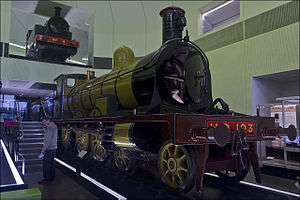Highland Railway Jones Goods Class
The Highland Railway Jones Goods class was a class of steam locomotive, and was notable as the first class with a 4-6-0 wheel arrangement in the British Isles. Fifteen were built, and one has survived to preservation. Originally known as the Big Goods class,[1] they became class I under Peter Drummond's 1901 classification scheme.
| Highland Railway Big Goods or class I "Jones Goods" | |||||||||||||||||||||||||||||
|---|---|---|---|---|---|---|---|---|---|---|---|---|---|---|---|---|---|---|---|---|---|---|---|---|---|---|---|---|---|
 Preserved No. 103 inside the Riverside Museum | |||||||||||||||||||||||||||||
| |||||||||||||||||||||||||||||
| |||||||||||||||||||||||||||||
| |||||||||||||||||||||||||||||
| |||||||||||||||||||||||||||||
Fifteen locomotives were built by Sharp, Stewart and Company and delivered between September and November 1894, numbered 103 to 117. At the time, these were the most powerful main line engines in the country. Originally intended principally as freight engines, they were often called upon for passenger duties during the wide fluctuations of traffic which occurred on the Highland Railway, particularly during the summer season.
Overview
The 4-6-0 wheel arrangement had its origins in the United States, and its introduction to Britain was the work of the Highland Railway's locomotive superintendent David Jones. When the 'Jones Goods' first appeared they were felt to be somewhat daring as they were such an advance on anything that Jones or the Highland Railway had previously built.
Although the type was a notable success for Jones, an accident while testing one of the locomotives caused one of his legs to be severely scalded. Although he recovered, he was permanently affected and by the end of December 1896 had retired due to ill-health.
Dimensions
Boiler pressure was 175 pounds-force per square inch (1.21 MPa) — the previous highest on the Highland being 160 pounds-force per square inch (1.10 MPa). Outside cylinders were 20-by-26-inch (508 by 660 mm), bore by stroke – the previous largest being 18-by-24-inch (457 by 610 mm). Driving wheels were 5 feet 3 inches (1,600 mm) in diameter — the HR standard for freight locomotives. Additionally the boiler and chassis were significantly longer than anything previously attempted by the company. It was also the first tender locomotive for the railway not to have Allan double frames and inclined cylinders beside the smokebox.
Transfer to LMS
The class was numbered 17916–17930 and given power classification '4F' by the London, Midland and Scottish Railway (LMS). They were withdrawn between 1929 and 1940.
Preservation
The first of the class, Number 103, (LMS 17916) was set aside for preservation by the LMS in 1934. It was restored to working order by British Railways in 1959 and spent several years operating enthusiasts' tours. During this time, it appeared in the 1965 film Those Magnificent Men in their Flying Machines. It was finally retired in 1966 and is today in the Glasgow Museum of Transport. In addition to being the first ever British 4-6-0, no. 103 has since 1966 also had the less positive distinction of being the only surviving former Highland Railway locomotive.
References
- Cormack & Stevenson 1988, p. 126.
- Baxter, Bertram (1984). Baxter, David (ed.). British Locomotive Catalogue 1825–1923, Volume 4: Scottish and remaining English Companies in the LMS Group. Ashbourne, Derbyshire: Moorland Publishing Company. p. 196.
- Casserley, H. C. & Johnston, Stuart W. (1974) [1966]. Locomotives at the Grouping 3: London, Midland and Scottish Railway. Shepperton, Surrey: Ian Allan. p. 183. ISBN 0-7110-0554-0.
- Casserley, H. C. (1974). British Steam Locomotives. London: Frederick Warne & Co. Ltd. ISBN 0-7232-1539-1.
- Cormack, J.R.H.; Stevenson, J.L. (1988). Greenwood, William (ed.). Highland Railway Locomotives Book 1: Early Days to the 'Lochs'. Locomotives of the LMS. Lincoln: RCTS. ISBN 0-901115-64-9.CS1 maint: ref=harv (link)
- Vallance, H. A. (1938). The Highland Railway
- Williams, Peter (1974). Britain's Railway Museums. Shepperton: Ian Allan Ltd. ISBN 0-7110-0565-6.